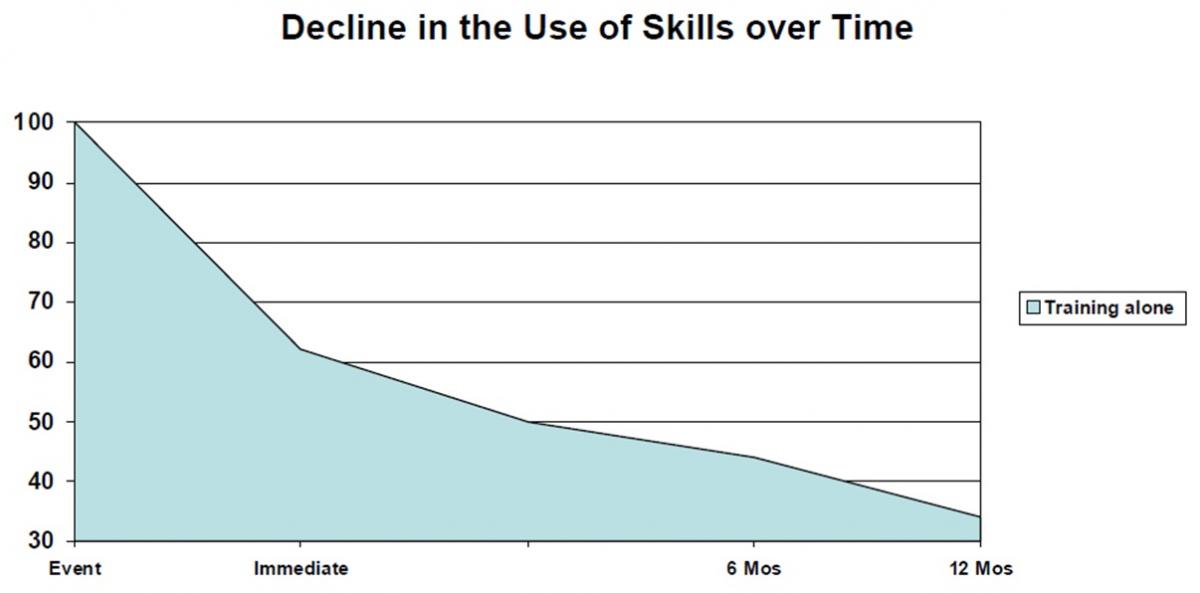Wilson Learning's Michael Leimbach recently conducted a study to show the impact of learning transfer activities on an organisation’s performance. Read on for more...
This first part of the report shows the findings of research into learning transfer activities and their ability to significantly the ROI for training and development efforts.
Learning transfer research
We all know that a training programme alone is not likely to result in significant changes in job performance, and much has been written about different techniques for ensuring that skills transfer into organisational performance improvement. However, while many have promoted specific activities to support the transfer of learning, there has been little research comparing the actual impact of these different techniques.
In this study, Wilson Learning reviewed the literature from recent years and found 32 research studies that compared the impact of training workshops alone, with training workshops plus one or more learning transfer activities.
This research allowed us to identify 11 specific actions that have a significant impact on whether training results in measurable performance improvement. Overall we found that if an organisation implemented all of these actions, they could improve the effectiveness of their learning by over 180%.
The outcome of this research is a model of learning transfer that is cost-effective to implement, captures the majority of transfer improvement actions, and has the maximum likelihood of improving the effectiveness of learning in your organisation.
Enhancing the impact of learning on performance
The fundamental purpose of learning and development is to help people develop skills which, when applied to work, enhance job and organisational performance. While this is widely acknowledged, how we measure the success of learning is not often in alignment with this idea. In fact, Kirkpatrick, the most popular model of reference for evaluating learning and development has three levels devoted to measuring learning outcomes, and only one measuring performance outcomes.
This focus on learning outcomes, rather than performance outcomes, has also influenced how learning has been designed and delivered for most of our industry's history. More recently, it has been widely researched (and largely accepted) that learning and development, as usually conducted, does not create performance change at an acceptable rate. In fact, most estimates suggest that only about 15 to 20% of the learning investments organisations make actually result in work performance changes.
For example, the graph below (from research conducted by Saks and Belcort in 2006) shows the decline in the use of learning on-the-job over time. The research clearly shows that for the average training and development programme, there is a steady decline in the use of new skills.
It is estimated that only about 35% of the skills are still in use 12 months after the typical training event.
Over the years, a number of people have offered theoretical models for how to enhance learning so that it results in greater impact on performance, and demonstrates a greater return on investment. This work goes under many names: extended learning, learning transfer, transfer climate, and relapse prevention, to name a few. In this article we will use the term 'learning transfer', because in our opinion, learning transfer best represents the desired outcome – transfer of learning to actual job performance.

There are several limitations to these theoretical models. First, most of them are quite complex, containing a large number of factors. Second, they are difficult, maybe impossible, to implement in any practical setting. Finally, while some of the models have a basis in research, they all began from a theoretical perspective, rather than from a practical perspective.
Therefore, the purpose of this research was to answer two basic questions: Can we identify sufficient research that documents the impact of specific learning transfer activities on the use of skills on the job? Then, from that research, can we construct a model that captures the essential components that support learning transfer most effectively?
The study
The first task of this study was to identify published and unpublished research that met three specific criteria:
- The research compared training alone, with training plus one or more learning transfer activities.
- The research reported statistically significant differences between training alone and training plus the learning transfer activities. This had to be more than anecdotal information so we could compare across studies.
- The outcome measures reported in the results needed to be performance outcomes, not learning outcomes.
Using a variety of sources, we identified research studies that met these criteria. We reviewed each study to identify the learning transfer action used, and identified how the performance difference was measured between training alone and training plus learning transfer activity. Many of the studies implemented multiple learning transfer activities. As a result we identified 32 studies that examined 66 different learning transfer activities.
Each study used its own statistical method for calculating the performance impact of the learning transfer activities (regression, ANOVA, t-test, etc.). Therefore, for each learning transfer activity we used the available statistical data and calculated a 'difference score' which represented the relative contribution of each learning transfer activity to the difference between training alone and training plus that learning transfer activity. That allowed us to compare across studies even though they used different statistical methods. This difference score represented the percentage improvement of training plus learning transfer over training alone. For example, a difference score of 20 indicated that that learning transfer activity improved the performance of the participants 20% over training alone.
Finally, to create a model that is less complex and easier to implement than the previous theory-driven models, we grouped similar transfer actions into common transfer activity categories. This led us to the Learning Transfer Model we describe in part two of this feature.
Findings
In summary, there are three broad conclusions that can be drawn from this research.
- This study provides convincing evidence that learning transfer activities have a meaningful impact on improving the performance results achieved from training alone. Taken together, the research suggests that the impact of learning can be enhanced by as much as 186% when all of the learning transfer methods are utilised.
- While learning transfer has a tremendous impact on performance, any one method may have a relatively modest impact. We found that taken alone, most learning transfer activities will improve performance about 20% over training alone. While significant, this is much below what others claim will happen.
- Finally, there is tremendous variability from study to study on the impact of learning transfer activities. While all of the studies tended to show significant and positive performance impact, the specific percent improvement varied widely. This clearly shows the need for further research in this area.
Michael Leimbach Ph.D. is head of research and development, Wilson Learning Worldwide








